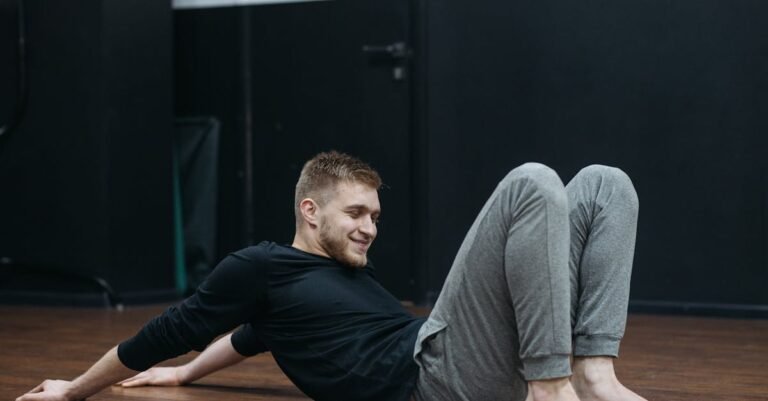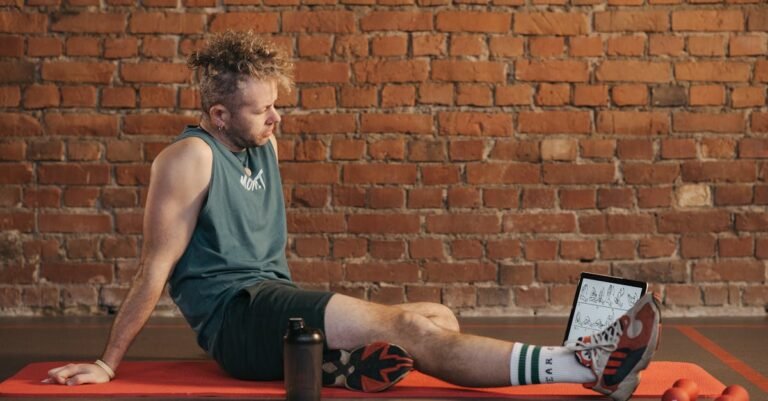Table of Content
- Mindful Movement: Connect Body And Mind
- What Exactly Is Mindful Movement?
- Why Bother Connecting Body and Mind? The Awesome Benefits
- Getting Started: Simple Ways to Practice Mindful Movement
- Integrating Mindful Movement into Daily Life
- Overcoming Challenges: Making it Stick
- Conclusion: Your Journey to Embodied Awareness
- Frequently Asked Questions (FAQs)
Mindful Movement: Connect Body And Mind
Ever feel like your head is in one place and your body is… well, somewhere else entirely? Like you’re just a brain piloting a meat-suit around, maybe occasionally bumping into things? You’re definitely not alone. In our fast-paced, digitally-driven world, it’s incredibly easy to live entirely in our thoughts, disconnected from the physical sensations and wisdom our bodies hold. But what if there was a way to bridge that gap, to bring your mind and body back into harmonious conversation? Enter mindful movement.
It sounds fancy, maybe even a bit mystical, but the core idea is beautifully simple: moving your body with conscious awareness. It’s about paying attention to the feeling of movement, not just going through the motions. Think less about crushing a workout and more about exploring the landscape of your physical self. Ready to ditch the autopilot and truly inhabit your body? Let’s dive in.
What Exactly Is Mindful Movement?
Okay, let’s break it down. “Mindful” means paying attention to the present moment, on purpose, without judgment. “Movement” is… well, moving! Put them together, and mindful movement is the practice of bringing that non-judgmental awareness to your physical actions. It’s not about achieving a specific pose, lifting a certain weight, or running a particular distance. It’s about the quality of your attention while you move.
Imagine sipping your favorite hot drink. You could gulp it down while scrolling through your phone, barely noticing the taste. Or, you could take a mindful sip: feeling the warmth of the mug, inhaling the aroma, noticing the temperature and flavor as it touches your lips and tongue. Mindful movement applies that same principle to how you inhabit and move your body.
Beyond Just Exercise: The Mindfulness Factor
Many forms of exercise can become mindful movement, but they aren’t inherently so. You can pound the pavement on a run completely lost in thought about work stress, or you can lift weights while mentally planning your grocery list. That’s movement, sure, but it’s not mindful movement.
The crucial difference is the intentional focus on your internal experience. What sensations are present in your muscles? How does your breath feel as it enters and leaves your body? Where do you feel contact with the ground? What is the trajectory of your arm as it swings? It’s about shifting from an external goal (finish the run, lift the weight) to an internal exploration (what does this feel like right now?).
Paying Attention on Purpose
This “paying attention on purpose” part is key. Our minds are naturally wanderers, like playful puppies constantly chasing squirrels (thoughts, worries, plans). Mindful movement gently encourages the puppy to stay present with the feeling of, say, stretching your hamstrings or the sensation of your feet on the floor. It’s not about forcing the mind to be silent – that’s impossible! It’s about noticing when the mind has wandered and gently, kindly guiding it back to the physical sensations of the present moment. Each time you bring your attention back, you’re strengthening that mindfulness muscle.
Why Bother Connecting Body and Mind? The Awesome Benefits
So, why add this layer of awareness to movement? Isn’t just moving enough? While any movement is better than none, weaving in mindfulness unlocks a whole treasure trove of benefits that go far beyond physical fitness. It’s like upgrading from standard definition TV to glorious 4K – suddenly, you perceive so much more detail and richness in your experience.
Stress Reduction: Saying Goodbye to Tension
Let’s face it, modern life is stressful. Our bodies often hold onto this stress, leading to tight shoulders, clenched jaws, and shallow breathing. Mindful movement acts like a gentle release valve. By tuning into physical sensations, you become aware of where you’re holding tension. You might notice your shoulders are practically kissing your ears! Simply noticing this, combined with conscious breathing and gentle movement, can help that tension begin to melt away. Moving mindfully interrupts the stress-feedback loop, calming the nervous system and promoting relaxation. It’s like giving your internal pressure cooker a safe way to let off steam.
Enhanced Body Awareness: Tuning In
How often do you really pay attention to your body’s signals until something hurts? Mindful movement cultivates interoception – the perception of sensations from inside the body. You start noticing subtle cues: the first hint of fatigue, the precise location of a stretch, the feeling of your balance shifting. This enhanced awareness is incredibly valuable. It can help prevent injuries by alerting you to push yourself too hard, improve your posture as you notice habitual slouching, and even help you recognise hunger and fullness cues more accurately. You become a more attuned listener to your body’s whispers, rather than waiting for it to shout in pain.
Improved Focus and Concentration
Remember that wandering puppy mind? Practicing mindful movement trains your attention. Each time you gently redirect your focus from a distracting thought back to the sensation of your breath or the feeling in your feet, you’re doing a mental push-up for your concentration muscles. This improved focus doesn’t just stay on the yoga mat or the walking path; it spills over into other areas of your life. You might find yourself better able to concentrate on work tasks, listen more attentively in conversations, or simply stay present with whatever you’re doing.
Emotional Regulation: Riding the Waves
Emotions aren’t just mental events; they have distinct physical signatures. Anger might feel like heat in the chest, anxiety like butterflies in the stomach, sadness like heaviness. Mindful movement helps you become more familiar with these physical correlates of your emotions. Instead of being overwhelmed by a feeling, you can learn to observe its physical sensations with curiosity. “Ah, there’s that tightness in my chest again. Interesting.” This creates a bit of space between you and the emotion, allowing you to respond more thoughtfully instead of reacting impulsively. You learn to ride the waves of emotion rather than being swept away by them.
Deeper Connection to Self
Ultimately, mindful movement fosters a profound sense of integration. You move beyond seeing your body as just a vehicle or something to be disciplined, and start experiencing it as an integral part of your being – a source of wisdom, sensation, and grounding. This practice bridges the perceived gap between mind and body, leading to a more holistic and compassionate relationship with yourself. You begin to feel more “at home” in your own skin, more present in your own life.
Getting Started: Simple Ways to Practice Mindful Movement
The beauty of mindful movement is its accessibility. You don’t need fancy equipment, expensive gym memberships, or hours of free time. You can start right now, with simple activities you might already be doing. The key is shifting your intention and attention.
Mindful Walking: Every Step Counts
Walking is something most of us do every day, often on autopilot. Mindful walking transforms this mundane activity into a rich sensory experience. Instead of thinking about your destination or replaying conversations in your head, bring your awareness to the act of walking itself.
Tips for Mindful Walking
Start by standing still for a moment. Feel your feet on the ground. Notice your posture. As you begin to walk, pay attention to:
- The sensation of your feet lifting and landing: heel, ball, toes.
- The subtle shift of weight from one foot to the other.
- The movement in your legs and hips.
- The gentle swing of your arms.
- Your breath – is it shallow or deep? Fast or slow?
- The feeling of the air or sun on your skin.
- The sounds around you, without judging them as pleasant or unpleasant.
You don’t need to walk slowly (unless you want to!). The pace doesn’t matter as much as the quality of your awareness. When your mind wanders (and it will!), gently guide it back to the sensation of walking.
Mindful Stretching: Releasing and Lengthening
Stretching often gets rushed at the beginning or end of a workout, or maybe squeezed in when you feel particularly stiff. Mindful stretching invites you to slow down and truly inhabit the stretch.
Instead of aiming for maximum flexibility or pushing into pain, focus on the sensations within the stretch. Where do you feel the pull? Is it sharp or dull? Notice the subtle shifts in sensation as you hold the stretch or deepen it slightly. Are you holding your breath? Can you breathe into the area being stretched?
Focusing on the Breath
Your breath is a powerful anchor during mindful stretching. Try inhaling as you prepare or slightly release a stretch, and exhaling as you gently move deeper into it. Notice how the breath can facilitate release and create space. Pay attention not just to the muscle being stretched, but to your whole body. Are you tensing your jaw or shoulders unintentionally? Can you soften those areas?
Yoga: The Classic Body-Mind Connector
Yoga is perhaps the most well-known form of mindful movement. While some styles emphasize athletic feats, the essence of traditional yoga lies in linking breath (pranayama) with movement (asana) and awareness. Each pose becomes an opportunity to explore sensations, balance, strength, and flexibility with a mindful attitude.
Focus on the transitions between poses as much as the poses themselves. How does it feel to move from standing to folding forward? What sensations arise as you hold Warrior II? Notice the interplay of effort and ease. Listen to your body’s limits, modifying poses as needed without judgment. The goal isn’t the perfect pose, but present moment awareness within whatever shape your body takes.
Tai Chi and Qigong: Flowing with Energy
These ancient Chinese practices involve slow, flowing, deliberate movements coordinated with deep breathing and mental focus. Often described as “meditation in motion,” Tai Chi and Qigong are explicitly designed to cultivate body awareness, balance, and the flow of internal energy (Qi).
The movements are typically gentle and low-impact, making them accessible to people of various fitness levels and ages. The focus is on fluidity, precision, and maintaining a calm, centered state of mind throughout the forms. Practitioners pay close attention to the weight shifts, the coordination of limbs, and the sensation of energy moving through the body.
Integrating Mindful Movement into Daily Life
You don’t need to set aside dedicated time slots for formal practice (though that helps!). Mindful movement can be woven into the fabric of your everyday activities, turning routine actions into moments of presence and connection.
Mindful Moments During Chores
Think about tasks like washing dishes, folding laundry, or sweeping the floor. These often feel tedious because our minds are elsewhere, wishing we were doing something else. Try bringing mindful awareness to these activities:
- Washing Dishes: Feel the warmth of the water, the slipperiness of the soap, the texture of the sponge, the movements of your hands and arms.
- Folding Laundry: Notice the different textures of the fabrics, the warmth from the dryer, the precise movements needed to fold each item.
- Sweeping/Vacuuming: Pay attention to the rhythm of the movement, the sound of the broom or vacuum, the feeling of your feet on the floor, the engagement of your core.
By focusing on the physical sensations, even chores can become a form of grounding, mindful practice.
Desk Stretches with Awareness
If you spend hours sitting at a desk, your body likely craves movement. Instead of just quickly stretching your neck or back, do it mindfully. Take 30 seconds to:
- Slowly roll your shoulders up, back, and down. Feel the muscles moving, releasing tension. Breathe deeply.
- Gently tilt your head towards one shoulder. Notice the stretch along the side of your neck. Don’t force it. Breathe. Repeat on the other side.
- Reach your arms overhead. Feel the lengthening through your spine and sides. Wiggle your fingers.
Even these micro-moments of mindful movement can break up sedentary time, reconnect you with your body, and refresh your focus.
Overcoming Challenges: Making it Stick
Starting a mindful movement practice is one thing; making it a consistent part of your life is another. It’s natural to encounter obstacles. Here’s how to navigate some common ones:
Dealing with Distractions
Your mind will wander. That’s not a sign of failure; it’s just what minds do. You’ll think about your to-do list, replay a conversation, worry about the future, or get lost in a random memory. The practice isn’t about eliminating thoughts, but about noticing when you’ve been carried away by them.
When you realize your attention has drifted, gently acknowledge the thought without judgment (“Ah, thinking”) and kindly redirect your focus back to the physical sensations of your movement or breath. Be patient and compassionate with yourself. Every time you bring your attention back, you’re strengthening your mindfulness muscle. It’s like training a puppy – gentle repetition is key.
Finding Time in a Busy Schedule
“I don’t have time” is a common refrain. But mindful movement doesn’t necessarily require adding another hour-long commitment to your day. Start small. Can you commit to five minutes of mindful stretching when you wake up? Can you practice mindful walking on your way to the bus stop or during your lunch break? Can you turn your dishwashing routine into a mindful moment?
Look for opportunities to integrate mindfulness into activities you’re already doing. Quality matters more than quantity, especially when you’re starting. Even a few minutes of dedicated, aware movement is far more beneficial than an hour of distracted exercise. Be creative and flexible, fitting it in where you can.
Conclusion: Your Journey to Embodied Awareness
Mindful movement isn’t just another fitness trend; it’s a pathway back to yourself. It’s an invitation to step out of the constant chatter of the mind and into the rich, sensory experience of your body, right here, right now. By intentionally bringing awareness to how you move – whether walking, stretching, doing yoga, or even washing dishes – you begin to dissolve the artificial barrier between mind and body.
The benefits ripple outwards: reduced stress, greater body awareness, improved focus, better emotional balance, and a deeper sense of connection to yourself and the world around you. It’s not about achieving perfection or eliminating thoughts, but about cultivating presence, curiosity, and kindness towards your own experience. So, take a deep breath. Feel your feet on the ground. And begin your journey, one mindful movement at a time. Your body and mind will thank you.
Frequently Asked Questions (FAQs)
FAQ 1: Do I need special equipment?
Absolutely not! One of the great things about mindful movement is its accessibility. Practices like mindful walking, simple stretching, or even mindful chores require nothing more than your body and your attention. While equipment like yoga mats can be helpful for certain practices like yoga, they aren’t essential to get started with the core principles of moving mindfully.
FAQ 2: How long should I practice mindful movement?
There’s no magic number. Consistency is more important than duration, especially initially. Starting with just 5-10 minutes per day can be highly effective. You could do a short mindful walk, a few mindful stretches, or dedicate a specific chore to mindful practice. As you get more comfortable, you might naturally want to extend your practice time. Listen to your body and your schedule – even brief moments count.
FAQ 3: Can I practice mindful movement if I have physical limitations?
Yes, absolutely. Mindful movement is adaptable. The focus is on internal awareness, not achieving specific physical feats. You can adapt movements to suit your abilities. For example, mindful stretching can be done seated, Tai Chi has modified forms, and even simply paying attention to your breath and subtle bodily sensations while resting can be a form of mindful practice. Always listen to your body, respect its limits, and consult a healthcare professional if you have concerns.
FAQ 4: Is mindful movement the same as meditation?
It’s closely related but not exactly the same. Think of mindfulness as the underlying quality of awareness. Traditional seated meditation often involves focusing on the breath or bodily sensations while still. Mindful movement applies that same quality of awareness *while* the body is in motion. So, practices like yoga or Tai Chi can be considered types of “meditation in motion.” Both seated meditation and mindful movement cultivate presence and awareness.
FAQ 5: What if my mind wanders a lot during practice?
Welcome to the club! A wandering mind is completely normal – it’s what minds are designed to do. The goal of mindful movement isn’t to stop thoughts altogether, but to notice when your attention has drifted away from the physical sensations of movement. When you notice this, gently and without judging yourself, simply redirect your focus back to your body or breath. Each time you do this, you are actively practicing mindfulness. Be patient and kind to yourself throughout the process.










